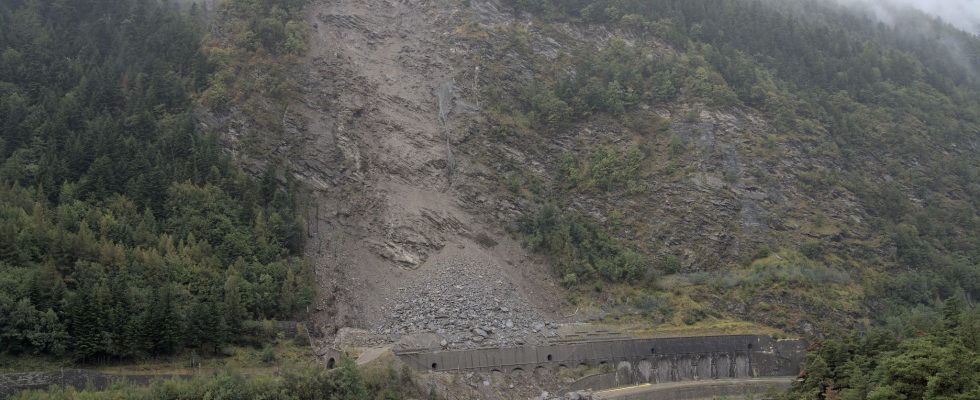A spectacular landslide of rocks in the Maurienne valley (Savoie) after a heat wave followed by heavy rains led to a suspension of rail traffic and heavy goods vehicles on a major axis between France and northern Italy. The return to normal could take several days, according to the authorities, and the sector has been under surveillance since Monday pending clearing.
Sunday around 5:15 p.m., “several blocks of rock representing a volume of around 700 m3” hit the protective screen installed on the RD 1006, in a “particularly monitored sector” in the town of Saint-André, in La Praz, explained the prefecture of Savoy in a press release.
On images broadcast on social networks, we can see a large plume of dust falling from a cliff and falling on the departmental road adjoining the railway line and the A43 motorway below.
Rains following a heat wave
The landslide occurred during a “rainy episode with significant runoff which followed a heat wave episode in all the Alps”, explained Denis Roy, head of the Northern Alps mountain center of Météo-France.
“This succession of hot weather followed by heavy rains” may have caused the instability of the rock, explained Serge Taboulot, president of the Institute of Major Risks in Grenoble, recalling the series of landslides that have occurred in recent days in the high mountains. “The mountain has always crumbled, but there are times that are more favorable than others, like this somewhat unusual heat wave,” he added.
For Ludovic Ravanel, geomorphologist at the CNRS, contacted by L’Express, it is difficult to say that the landslide is linked to global warming. “As much as the link between global warming and rock destabilization is very clear at high altitude, where there is permafrost (terrain whose temperature remains permanently negative, between 2,500 and 3,000 meters), as much for what has passed in the Maurienne (less than 1,000 meters above sea level), the effect is very tenuous”, he says.
“I rather tend to say that what happened was a natural event, which was triggered by a series of two quite different meteorological contexts, he explains, in this case a heat wave which had tendency to dry out the land, and heavy precipitation which, when it penetrates the cracks in the rock, increases what is called hydraulic pressure, or pore pressure, which is enough to trigger destabilization”, explains the expert. .
Towards an increase in landslides
The specialist in the evolution of high mountain environments recognizes, however, that global warming is not totally unrelated to this type of landslide. This leads “effectively to an increase in what are called climatic extremes, heavy rainfall, periods of heat wave, which will promote rock destabilization beyond the permafrost zones”, he says.
But it is above all at high altitude that Ludovic Ravanel observes “an almost exponential increase in the number of collapses (slides above 100,000 cubic meters) since the 1990s, with a very clear, very clear link with global warming. climate” which leads to “permafrost degradation”.
In the coming years, it is to be expected, “where there is a very present permafrost, an increase in the number of these landslides and volumes which may well exceed one million cubic meters”, advances the geomorphologist. These phenomena are all the more dangerous as they can “through cascading effects, avalanches, mudslides, reach the valleys”.
